The so-called jinwen 金文 "bronze texts" are inscriptions on ritual bronze vessels from the Shang 商 (17th-11th cent. BCE) and Zhou 周 (11th cent.-221 BCE) periods, but also on other objects of the Warring States 戰國 (5th cent.-221 BCE), Qin 秦 (221-206 BCE) and Han 前漢 (206 BCE-220 CE) periods. Post-Han inscriptions on metal objects are not counted among jinwen texts.
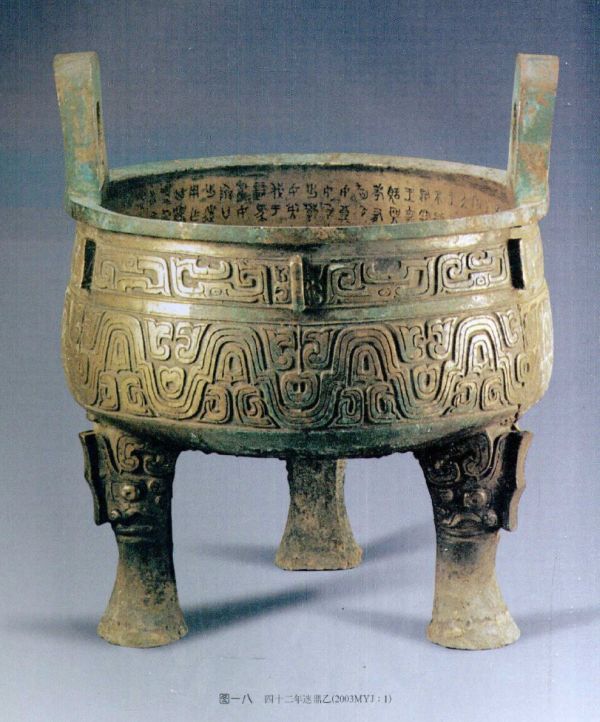 |
Example of a ding-type tripod with inscriptions inside. This is the second of a set of tripods discovered in Yangjiacun 楊家村, Meixian 眉縣, Shaanxi. The vessel is called Sishi'er nian lai ding 四十二年逨鼎. From Shaanxi Kaogu Yanjiusuo (1993). |
The oldest inscriptions date from the Erligang 二里岡 phase (13th cent. BCE) of the Shang period. The apogee of jinwen texts was the Western Zhou period 西周 (11th cent.-770 BCE). Some scholars use the term jinwen only for inscriptions on ritual bronze vessels and bells, and not for other objects like bronze tallies, weights, and standard measures.
The history of research in bronze vessels and their inscriptions is ancient. From the Former Han period on, scholars were interested in the dating and the texts of the vessels unearthed in tombs and hoards, like Zhang Chang 張敞 (d. 47 BCE), who analysed the texts of a ding 鼎 tripod unearthed in Meiyang 美陽.
The Song period 宋 (960-1279) was the high time of bronze inscription research. The most famous of these studies is Lü Dalin's 呂大臨 (1044-1091) Kaogutu 考古圖, a richly illustrated catalogue on old bronze vessels and their inscriptions. Other books are Huangyou sanguan guqi tu 皇祐三館古器圖, Liu Chang's 劉敞 (1019-1068) Qianqin guqi ji 先秦古器記, and Li Gonglin's 李公麟 (1049-1106) Kaogutu 考古圖.
While these books are descriptive catalogues of collectors' possessions, there were also more systematic listings, like Xue Shanggong's 薛尚功 (fl. 1144) Lidai zhongding yiqi kuanzhi fatie 歷代鍾鼎彜器款識法帖, or even character dictionaries for bronze texts, like Kaogutu shiwen 考古圖釋文 by Lü Dalin and or Zengguang zhongding zhuan yun 增廣鍾鼎篆韻 by Yang Jun 楊銁 (c. 1300).
A second heyday of the research in bronze inscriptions was during the Qing period 清 (1644-1911), when scholars were again interested in practical text-critical research, rather than in the metaphysical speculations of the Neo-Confucians. The most important collections of bronze inscriptions were Jiguzhai zhongding yiqi kuanzhi 積古齋鍾鼎彜器款識 by Ruan Yuan 阮元 (1764-1849), Jungulu jinwen 攟古錄金文 by Wu Shifen 吳式芬 (1796-1856), Chuoyizhai yiqi kuanzhi 綴遺齋彜器款識 by Fang Junyi 方浚益 (d. 1899), Kezhai jigulu 愙齋集古錄 by Wu Dacheng 吳大澂 (1835-1902), and the books Guzhou shiyi 古籀拾遺 and Guzhou yulun 古籀餘論 by Sun Yirang 孫詒讓 (1848-1908). The best character dictionary of this time is Wu Dacheng's Shuowen guzhou bu 說文古籀補.
During the Republican period (1912-1949), scholars like Luo Zhenyu 羅振玉 (1866-1940; author of Sandai jijin wencun 三代吉金文存), Wang Guowei 王國維 (1877-1927) and Guo Moruo 郭沫若 (1892-1978; author of Jinwen congkao 金文叢考, Liangzhou jinwen ci daxi 兩周金文辭大系) developed scholarly criteria to establish methods for dating the inscriptions and using them as historiographical sources.
A large number of books was compiled by Chinese and overseas scholars, of which only several can be listed here: Yang Shuda's 楊樹達 (1885-1956) Jiweiju jinwen shuo 積微居金文說, Rong Geng's 容庚 (1894-1983) Shang-Zhou yiqi tongkao 商周彜器通考 and the lexica Jinwenbian 金文編 and Jinwen xubian 金文續編, Yu Xingwu's 于省吾 (1896-1984) Shuangjianchi jijin wenxuan 雙劍誃吉金文選, Ke Changji's 柯昌濟 (1902-1990) Jinwen fenyu bian 金文分域編, Tang Lan's 唐蘭 (1901-1979) Xizhou qingtongqi mingwen fendai shizheng 西周青銅器銘文分代史證, Chen Mengjia's 陳夢家 (1911-1966) Xizhou tongqi duandai 西周銅器斷代, the book Jinwen tongshi/Kimbun tsūshaku 金文通釋 by the Japanese scholar Shirakawa Shizuka 白川静 (1910-2006), as well as the handbooks Jinwen gulin 金文詁林 by Zhou Fagao 周法高 (1915-1994), Sun Zhichu's 孫稚雛 (b. 1938) Jinwen zhulu jianmu 金文著錄簡目 and Qingtongqi lunwen suoyin 青銅器論文索引, or the book Xinchu jinwen fenyu jianmu 新出金文分域簡目 published by the Archaeological Department of the Chinese Academy of Social Sciences (Zhongguo Shehui Kexueyuan Kaogu Yanjiusuo 中國社會科學院考古研究所).
The most extensive compendium of bronze inscriptions, containing rubbings as well as transcriptions into modern script, is the book Yin-Zhou jinwen jicheng 殷周金文集成, published in 1984 by the institution just mentioned.
The bronze vessel inscriptions are of great importance for historians, because they can supplement information not given in the transmitted sources, as the universal history Shiji 史記 or the Classic Shangshu 尚書 "Book of Documents". They are also essential tools for the study of ancient Chinese characters, as a supplement to the renowned, but often faulty, character dictionary Shuowen jiezi 說文解字.
The oldest inscriptions from the Erligang period (13th cent.) are only preserved on a minimal number of vessels, and the inscriptions bear only one to three characters. The characters are cast into the vessels and are protruding (yangwen 陽文), which means that the characters or signs have been carved into the mould. Some of the inscriptions are names of families, some are the names of an ancestor, to whom the vessels were dedicated during the sacrifice, and some inscriptions might even give a hint of the use of the vessel. Because most of the objects were not excavated by archaeologists but found their way to museums over the (black) antiques market, it cannot be proved whether they are genuine Erligang vessels or forgeries.
The inscriptions of the Yin period 殷 (12th-11th cent.), that is, the last part of the Shang era, are longer, but still relatively short, the longest bearing some 50 characters. The content of the inscriptions is similar to the Erligang pieces, containing the names of families or owners, or the names of ancestors to whom sacrifices were made. The insignia of families (zuhui 族徽) cannot directly be interpreted as Chinese characters, but have a rather "heraldic" meaning. Some have the shape of a person (anthropomorph), some that of animals (zoomorph). Part of these insignia has been interpreted as ancient forms of Chinese characters, while some of them might later have been used as place names. The inscriptions are often to be found in several parts of the vessels, depending on the shape. Usually, the inscription is found on the interior side of the vessel.
 |
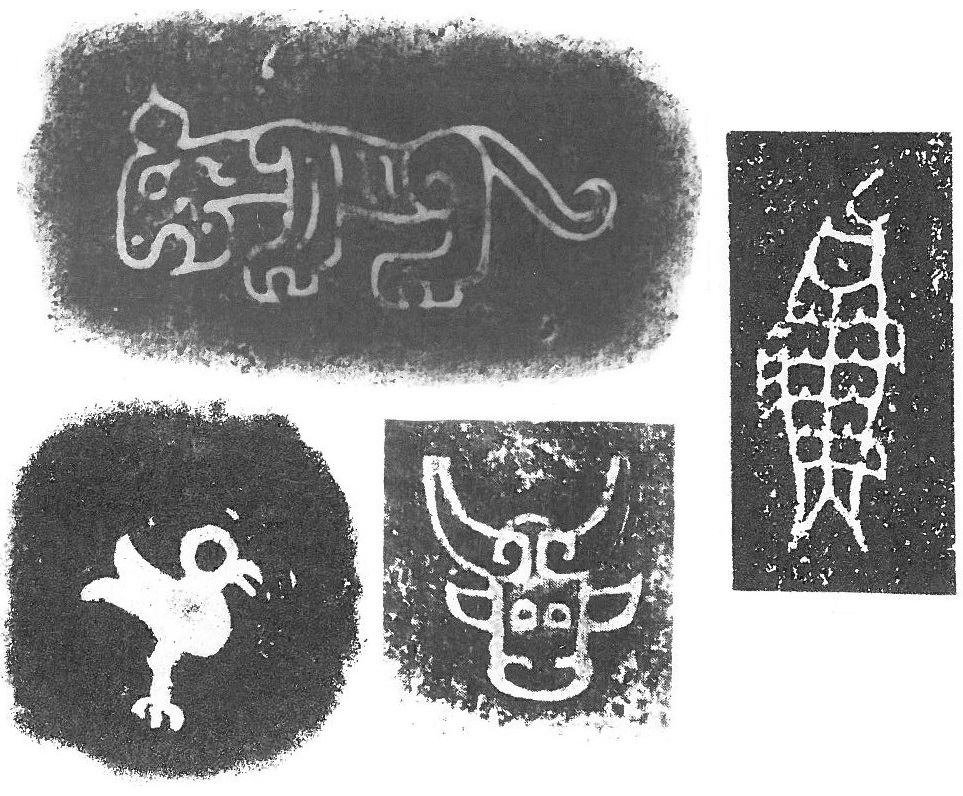 |
Examples of anthropomorph and zoomorph insignia on bronze vessels. Zhongguo shehui kexue yuan kaoguxue yanjiusuo (1984), nos. 2915-2916, 2918-2921, 2973-2974, 2979, and 2983. |
|
 |
|
Examples of insignia on bronze vessels, with signs 史, 戈, and a pattern. Zhongguo shehui kexue yuan kaoguxue yanjiusuo (1984), nos. 2961, 3002, and 3021. |
|
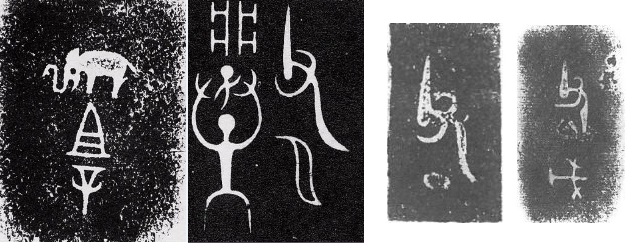 |
|
Examples of inscriptions on bronze vessels, saying "[dedicated] to Ancestor VIII from the Xiang [family] 象且(=祖)辛 / Father II from the [family] 父乙 / Father IV 父丁 / Father V 父戊 "". Zhongguo shehui kexue yuan kaoguxue yanjiusuo (1984), nos. 1512, 1523, 3054, and 3055. |
|
| 史 | "[Vessel of/for] Shi (the Scribe)" (1073) |
| 吏從乍(=作)寶盤 | "Precious plate made by Officer Cong" (10061) |
| 乍(=作)旅簋 | " cast [this] pot for the Lü family" (3378) |
| 寑小室盂 | "Pot of the small sleeping/burial (?) chamber" (10302) |
| 曾仲斿父用吉金自乍(=作)尊壺 | "Father Middle Ancestor You used noble metal [i.e., bronze] to make for himself a venerable can" (9628) |
| 己華父乍(=作)寳鼎子子孫孫永用 | "Father VI Hua made a precious tripod, to be hold in esteem by his sons and grandsons in eternity" (2418) |
Numbers refer to Zhongguo shehui kexue yuan kaoguxue yanjiusuo (1984). |
|
| 戈父己 | "Father Ji of the Ge branch" (found on 1606 ding, 4954 you, 7135 gu, 8555 jue, ss141 gui, ss149 zhi |
| 子申父己 | "Zishen for Father VI" (1873) |
| 衛乍(=作)父庚寳尊彜 | "Wei made this precious honoured vessel for Father VII" (3612) |
| 小臣乍(=作)父乙寳彜 | "The senior serviceman made this precious vessel for Father II" (found on 5268 you and 5870 zun) |
| 陵乍(=作)父日乙寳畾(=罍) / 單 | "Ling made this precious jar for Father Ri II, by Dan (?)" (9816) |
Numbers refer to Zhongguo shehui kexue yuan kaoguxue yanjiusuo (1984). |
|
The Si si Biqi you 四祀𠨘其卣 (5413) pot bears an inscription of 42 characters in 8 columns on the outer bottom, and two identical inscriptions on the inner bottom and the inner side of the cover, with 4 characters indicating the family (Mo 亞{獏}) and the ancestor (Fu Ding 父丁 "Father Four"). The lengthy inscription says that the vessel was bestowed on the family after the king had made a sacrifice to his ancestor. From the inscription, the receptacle can be dated to the fourth year of King Di Xin 帝辛 (r. 1060-1027 BCE).
| 乙子(=巳)王曰(=尊)/文武帝乙宜。/才(=在)(=召)大(=庭) 。𢔵(=遘)/乙羽(翌)日。丙午。/丁未。己酉王/才梌𠨘其易貝。/才四月隹(=唯)/王四祀翌日。亞{獏}*,父丁。 | On the day with the cyclical signs yisi, the King said: "We will hold an yi ceremony 宜 [offering wine and meat] to our royal ancestors.” [The ceremony was held] in the Great Assembly Hall. It happened that this was exactly the day for the ceremonies for the dynastic ancestor (Tang the Perfect). On the day bingwu, the offerings (meal transferral?) were brought, and on the day dingwei, the offerings. On the day jiyou, the King was in Tu 梌 and presented Biqi 𠨘其 with cowry shells. It was in the fourth month of the fourth royal year, when the sacrifices were brought. Mo 亞獏* for Father IV. |
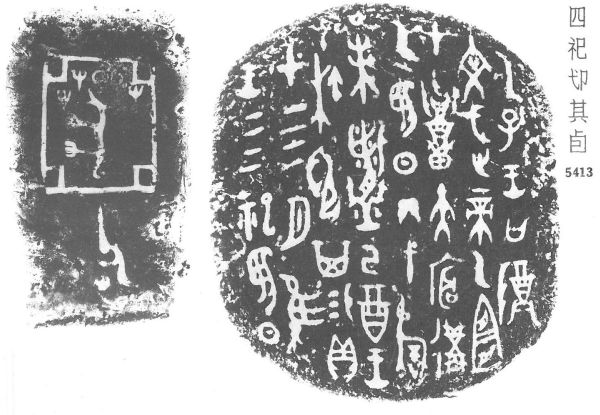 |
|
* The character 獏 is enclosed by 亞 (see rubbing). The sign / symbolises a word wrap. Rubbing from Zhongguo shehui kexue yuan kaoguxue yanjiusuo (1984), translation according to Jinwen jinshi leijian bianxiezu (2003). |
|
The longest inscription of the Shang period is that on the pot Xiaozi X you 小子卣 (5417), which was bestowed on a grandee who had taken over the task to supervise some submitted tribes (renfang 人方).
| 乙子(=巳)。子令(=命)小子先㠯(=以)人于堇。子光商(=賞)貝二朋。子曰。貝售(=唯)〔丁*〕蔑女(=汝)𤯍。用(=作)母辛彝。才(=在)十月〔二*〕。隹(=唯)子曰。令朢人方䍙。母辛。 | On the day with the cyclical signs yizi, the Baron ordered Small Officer to take with him some men and go to Jin 堇. The Baron graciously presented Small Officer with two pieces of cowry shells. He said, with these shells, I reward your serious sense of duty. On this occasion, had a vessel cast for his ancestress Mother VIII. It was in the tenth month, when the Baron ordered [] to investigate the region of Mei 䍙, where the Renfang 人方 tribes live. Mother VIII of the family. |
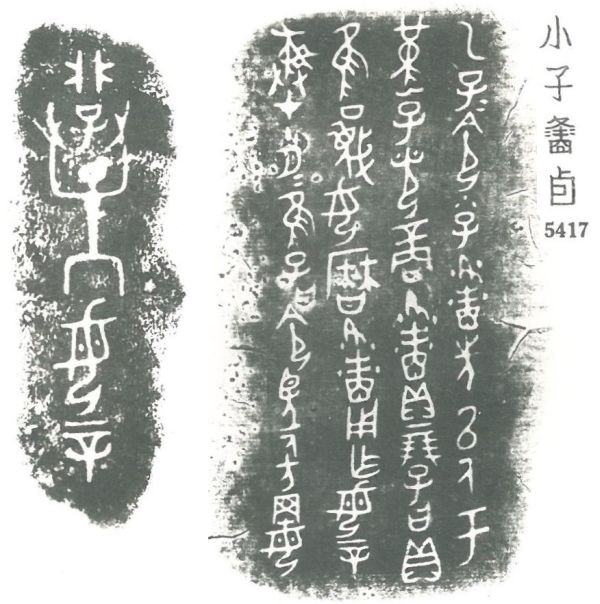 |
|
* Superfluous characters. Rubbing from Zhongguo shehui kexue yuan kaoguxue yanjiusuo (1984), translation according to Jinwen jinshi leijian bianxiezu (2003). |
|
But the shorter inscriptions are no less informative, like the many vessels found in a tomb in Xiaotun 小屯 near Anyang 安陽, Hebei, where the capital of Yin was located. All bronze vessels excavated in one single tomb bear the inscription Fu Hao 婦好, so that the name of its owner could be identified as the consort of King Wu Ding 武丁.
The language of the Yin-period inscriptions, as well as the shape of the characters, is very similar to that in the oracle bone inscriptions dating from the same time.
The Western Zhou-period 西周 (11th cent.-770 BCE) inscriptions perpetuate the traditions founded by the Shang rulers, but the inscriptions become more extended and more narrative, almost of a literary quality. The content is also diversified. It is primarily the longer inscriptions which are similar to the royal speeches found in the Shangshu, like, for example, the 400-characters long text of the Xiaoyu ding 小盂鼎 tripod (2839) from the time of King Kang 周康王 (10th cent.). It almost seems that inscriptions in bronze vessels were used for the compilation of the Shangshu.
In fact, numerous inscriptions give additional information which is not provided in the traditional written sources. The conquest of the Shang by the Zhou ruler King Wu 周武王 is dated in the inscription of the Li gui 利簋 pot (4131).
| 珷(=武王)征商。隹(=唯)甲子朝歲鼎(=當) 。克䎽。𡖊(=夙)又(=有)商。辛未。王才(=在)𠂤。易(=賜)又事利金。用乍(=作)公寶(=尊)彝。 | When King Wu attacked the Zhou, it was a day with the cyclical signs jiazi, and in the morning, when Jupiter was just rising [above the horizon]. He defeated the benighted [king of Shang and thereupon] took [the territory of] Shang. On the day xinwei, the King was in 𠂤 and presented Li 利, who had taken over duties [during the battle] with [raw] bronze. [Li] used it to have a precious ceremonial vessel cast for the [sacrifices] to Duke . |
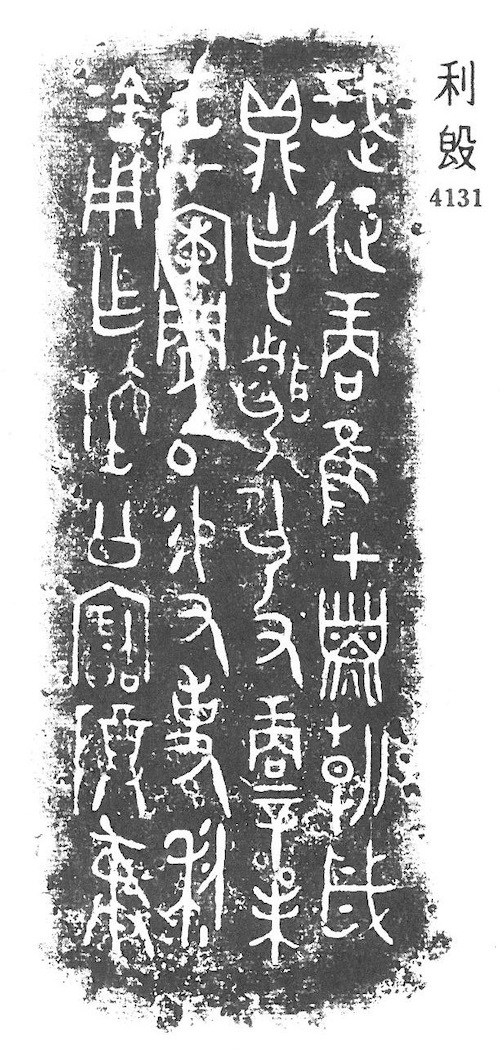 |
|
Rubbing from Zhongguo shehui kexue yuan kaoguxue yanjiusuo (1984), translation according to Jinwen jinshi leijian bianxiezu (2003). |
|
The Duke of Zhou's 周公 campaigns the east to quell the rebellions of the royal princes are mentioned in the X fangding 方鼎 pot (2739).
| 隹(=唯)周公X(=于)征伐東尸(=夷)。豐白(=伯)。尃(=薄)古(=姑)。咸𢦏。公歸于周廟。戊辰。酓秦酓。公X(=賞)貝百朋。用乍(=作)(=尊)鼎。 | When the Duke of Zhou campaigned against the Eastern Yi tribes 東夷, the [rebellious] Earl of Feng 豐 and the state of Bo Gu 薄姑 were completely extinguished. The Duke returned and reported [his victory] in the ancestral hall of the Zhou. On the day with the cyclical signs wuchen, he feasted with wine from Qin, and presented with one hundred pieces of cowry shells. On this occasion, had a ceremonial tripod cast. |
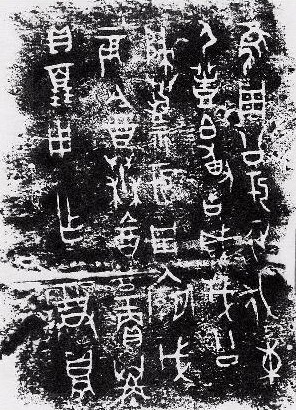 |
|
Rubbing from Zhongguo shehui kexue yuan kaoguxue yanjiusuo (1984), translation according to Jinwen jinshi leijian bianxiezu (2003). |
|
There is a mention of Marquis Kang's 康侯 appointment as ruler of Wei 衛 and the transfer of Marquis Ze 夨侯 from Yu 虞 (i.e., Wu 吳) to Yi 宜 in the Yi hou Ze gui 宜侯夨簋 pot (4320).
The southern campaigns of King Zhao 周昭王, as well as the inspection travels of King Mu 周穆王, both in the 10th century, are also recorded.
A prevalent type of inscription was made as a memory to celebrate a royal command (ceming 冊命) or a royal gift, as can be seen in the inscriptions of the Xiao Ke ding 小克鼎 tripod (2796) or the Kang ding 康鼎 tripod (2786).
| 隹(=唯)王廿又三年九月,王 / 才(=在)宗周,王命譱(=膳)夫克舍 / 令(=命)于成周,遹正八𠂤(=師)之 / 年。克乍(=作)朕皇且(=祖)季釐寶 / 宗彝。克其日用䵼,朕辟魯 / 休,用匄康𪟣(=樂)、屯(=純)右(=祐)、𧸧(=眉) / 𦓃(=壽)、永令(=命)、霝(=令)冬(=終)。邁(=萬)年 / 無彊(=疆),克其子子孫孫永寶用。 | In the ninth month of the 23rd year, the king was dwelling in Zongzhou 宗周. The king instructed Food Steward Ke 克 to go to Chengzhou 成周 to bring order into the eight battalions. Me, Ke, thereupon had this precious vessel cast for the veneration of my eminent ancestor Ji Li 季釐. On this very day, I, Ke, used a jiang 䵼 vessel, wishing happiness to my ancestor, praying for health and joy, spirited support, long life, and happy twilight years; for ten thousand years without end. May my sons and grandsons use this vessel in eternity. |
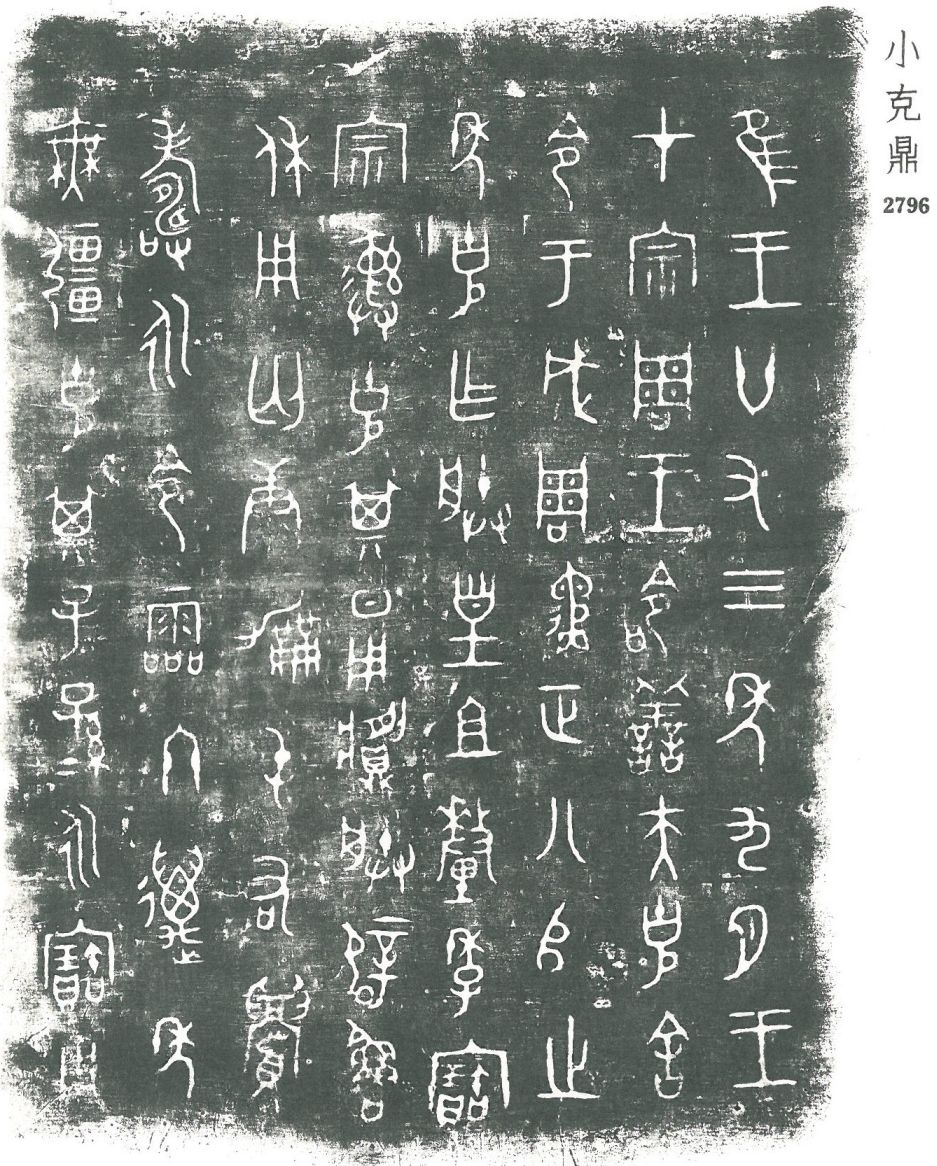 |
|
Rubbing from Zhongguo shehui kexue yuan kaoguxue yanjiusuo (1984), translation according to Jinwen jinshi leijian bianxiezu (2003). |
|
| 唯三月初吉甲 / 戌。王才(=在)康宮。 |
It was in the third month, in the auspicious first decade, on the day with the cyclical characters jiaxu. The King resided in the Palace of Strength 康宮. The Earl of Rong 榮伯 entered, assisting Kang 康 [Earl Li]. The King ordered: "[Until your] death, you shall supervise the royal household. [We] present you with a dark sash and bronze-decorated bridles." Kang kowtowed, daring to raise in thanks the brilliant grace of the Son of Heaven. Therefore [I] ordered to cast this precious tripod for my cultured father, Earl Li 文考釐白伯. [My] sons and grandsons shall hold in high esteem for ten thousand years and use it in sacrifice. |
 |
|
Rubbing from Zhongguo shehui kexue yuan kaoguxue yanjiusuo (1984), translation according to Jinwen jinshi leijian bianxiezu (2003). |
|
The characters of the early Western Zhou are still quite bold and crude, but become more standardised from the mid-Western Zhou period on. The larger inscriptions of the mid-Western Zhou mainly deal with charges issued by the kings of Zhou, or appointments of the regional rulers, which were often accompanied by the bestowal of gifts. Some inscriptions also deal with economic and territorial exchanges between regional rulers, which had to be sanctioned by the king, like in the Hu ding 曶鼎 tripod (2838).
The Qiu Wei he 裘衛盉 can (9456) describes three exchanges between Qiu Wei 裘衛 and Qu Bo 矩伯, some of them land against land, others land against furs or money.
Territorial disputes are dealt with in the long inscription of the San shi pan 散氏盤 (10176) plate.
Of the late Western Zhou inscriptions, that of the Mao gong ding 毛公鼎 tripod (2841) is the longest (479 characters, investiture of Duke Mao). This inscription belongs to the type of royal instructions (xungao 訓誥).
| ...王曰。父𢉩。今余唯𤕌先王命。命女亟一方。我邦。我家。母顀于政。勿雍庶人。母敢龏㯱。龏㯱廼敄鰥寡。善效乃友正。母敢湎于酉。女母敢㒸才乃服。𡖊夕。敬念王畏不睗。女母弗帥用先王乍明井。俗女弗厶乃辟圅于𡅸。... | [...] The King said: "Elder Yin! Now I want to carry on the Mandate of our royal ancestors. I charge you to be a model [ruler] for all the regional powers, in order to bring peace and tranquillity to our State and to our House. Do not show partiality in government. Do not deprive commoners of their stores. Do not dare to enrich yourself at their expense, if you do so, you take advantage of widows and widowers. Skillfully give instructions to your colleagues and your seniors. Do not dare to drink wine to excess. Do not be negligent in your duties. Day and night, remember that the royal majesty is not to be taken lightly. You must give leadership and avail yourself of the penal statutes made illustrious by the former Kings. It is my earnest wish that you should not because of your responsibilities become involved in trouble." [...] |
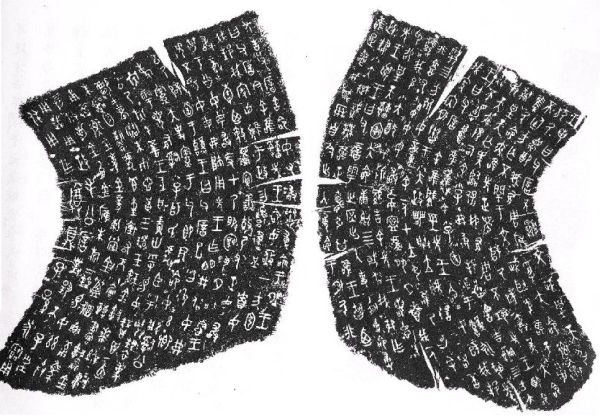 |
|
Rubbing from Zhongguo shehui kexue yuan kaoguxue yanjiusuo (1984), translation according to Dobson (1962). |
|
The plate Guo Jizi Bo pan 虢季子白盤 (10173) gives an impression of the political turmoil of the late Western Zhou period.
The inscription of the tripod Duoyou ding 多友鼎 (2835) contains a report of a campaign against the western Xianyun 獫狁 tribes.
The plate Xijia pan 兮甲盤 (10174) gives information on the wars against the southeastern tribes of the Huai region (Huaiyi 淮夷). Likewise the jar Jufu xu 駒父盨 (4464).
Many bronze vessels were excavated from tombs, while others were buried in the earth as "hoards" to prevent their capture by enemies. It can be seen that the possession of ritual bronze vessels was a preeminent duty of a noble family. This is also seen in the inscriptions, which often end with the formula zizi sunsun yong bao yong 子子孫孫永寶用 "may my sons and grandsons use this vessel in eternity" (and similar).
In the 8th century, the quality of the vessels and the inscriptions gradually deteriorated, like, for instance, in the set of vessels called Liangqi (=梁)其, which uses unusual expressions. With the flight of the house of Zhou to the east, the number of vessels cast by the royal house drastically declined. Instead, the regional rulers, even those of the lesser states, started issuing decrees on bronze vessels, and thus took over a task formerly exerted by the kings of Zhou.
The inscriptions of the Eastern Zhou period, especially the Spring and Autumn period 春秋 (770-5th cent. BCE), reflect the growing power of the regional rulers who took over the hegemony over the smaller regional states, like the states of Jin 晉, Qi 齊 (Geng hu 庚壺) or Chu 楚 (Ling Yinzi Geng ding 令尹子庚鼎). The pot Geng hu 庚壺 (9733) describes the campaigns of Duke Ling 齊靈公 of Qi against the Lai 萊 barbarians.
One famous inscription from the state of Jin is the story of a ducal consort, the tripod Jin Jiang ding 晉姜鼎 (2826).
The administrative and ritual vocabulary of the southern state of Chu was somewhat different from that of the north, as can be seen in the inscription of the Wangzi Wu X ding 王子午鼎 tripod (2811). Yet some scholars say the Chu inscriptions show stylistic vicinity to the Zuozhuan Commentary 左傳.
In the far west, the state of Qin 秦 also cast its own vessels with inscriptions, like the Qingong zhong 秦公鍾 bells (262-266), the Qingong gui 秦公簋 (4315, see inscription), or the Qingong bo 秦公鎛 bells (267-270). The characters of the Qin inscriptions look different from those of the "central states".
Yet the other states also developed their distinctive types of writing, like the kedouwen 科斗文 style of Jin with a thick corpse and slim ends, or the "bird-style" (niaoshu 鳥書) of the southern states. This development intensified over time.
Additionally, the wording used in the inscriptions was also, in certain points, different across various regions. The characters were no longer produced during the casting process but engraved after the piece was finished, often filled with golden alloys (cuojin 錯金). The technical development of crafts also altered the appearance of the vessels and their inscriptions.
The content of the inscriptions also evolved. The old pattern of investiture or royal charges disappeared and was replaced by an inscription of the craftsmen's names, the users, the region of use, and, in the case of weights and measures, a specific indication of the weight or volume. Many items now also bore a concrete date of when they were made or brought into use.
Most inscriptions on bronze objects are, therefore, quite short, but there are also examples of lengthy inscriptions, like the 448-characters long inscription on the Zhongshan wang (Xi?) fanghu 中山王方壺 (9735) and the 469-characters long on the Zhongshan wang ding 中山王鼎 (2840), which is famous for its delicate style of writings with long and slender characters. The inscriptions describe the conquest of a part of the territory of Yan 燕 by the army of Zhongshan 中山, an incident not covered by traditional written sources.
During the Warring States period, it became common to record the name of craftsmen, along with that of the owner or user and place names. Moreover, inscriptions were applied to weights and measures, indicating the exact quantity. In some objects, dates are inscribed (by using the ganzhi system of the sexagenarian cycle, see calendar), or "serial numbers" of early "mass production".
| 三年。漆工巸。丞詘造。工隸臣牟。禾石。高奴。 | Third year. [Supervisor] Master Yi 巸 from Qi 漆. Crafted by Aide Qu 詘. Worked by penal labourer Mou 牟. He Shi 禾石. Gao Nu 高奴. (Gao Nu He Shi tongquan 高奴禾石銅權, 10384) |
 |
|
Drawing from Qiu Guangming (1982). |
|
With the foundation of the Qin empire, the term "imperial instruction" (zhaoshu 詔書) found its way into inscriptions, in the shape zhaoliang 詔量 "legal volume measure" or zhaoquan 詔權 "legal weight". The Han took over these customs and did indeed produce a large number of inscribed tools, some of them even in sets (weights, rulers, volumes). Inscriptions of the Qin and Han were collected by Rong Geng 容庚 (1894-1983; Qin-Han jinwen lu 秦漢金文錄 and Jinwen xubian 金文續編). Quite interesting is the comparison of official titles in inscriptions with those preserved on seals. Objects from the reign-period of Wang Mang 王莽 (r. 8-23 CE) remained the same as during the Former Han, but the inscriptions imitate ancient styles.
The shape of objects changed drastically during the Warring States and Han periods. While the old ritual vessels like ding, gui, li or jue vanished, new types of bronze objects appeared, and the shape of cans or pots changed. At the same time, the content of inscriptions changed, for instance, to wishes for health and longevity, as seen in the richly decorated cans unearthed in Mancheng 滿城, Hebei. Quite famous among the Mancheng bronze objects is the lamp (or sublimation tool?) with the shape of a servant girl holding a lantern or the incense burner in the shape of a mountain of immortals (see Xiao 1972).